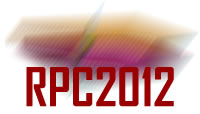Marcello Abbrescia
(Università and INFN - Bari - Italy)
The Extreme Energy Events experiment has been concieved by its leader, prof. A. Zichich, and joins the scientific interest of a real cosmic rays physics experiment with the enormous didactic potentiality deriving from letting it be carried on by high school students. It consists of an extended network of telescopes made by three Multigap Resistive Plate Chambers each, designed to monitor the muon cosmic rays flux and detect very-high energy extended atmospheric showers; each telescope is located in a high school on the Italian territory and, after the initial set up phase, is continuously operated and monitored just by students and teachers.
A very good performance, in terms of efficiency, space and time resolution is essential to achieve its physics goals, and therefore the detectors used must assure a front-line performance, similar to the one presently achieved at the LHC experiments. In this talk, after briefly discussing the experiment layout, a review about the detector construction, installation and commissioning, will be done, and some measurements on the actual perfomance of the MRPCs installed in the various telescopes will be shown.
After the initial phase, the experiment is starting to continously take data, and the first physics interesting results have been obtained, demonstrating the validity of the idea of running a real physics experiment in these peculiar conditions. A short review of the observations of extended showers by the stations of the EEE experiment, and of the 2011 February Forbush decrease, which both give very intriguing informations in this field, will complete the talk.
Summary
The Extreme Energy Events experiment has been concieved by its leader, prof. A. Zichich, and joins the scientific interest of a real cosmic rays physics experiment with the enormous didactic potentiality deriving from letting it be carried on by high school students. It consists of an extended network of telescopes made by three Multigap Resistive Plate Chambers each, designed to monitor the muon cosmic rays flux and detect very-high energy extended atmospheric showers; each telescope is located in a high school on the Italian territory and, after the initial set up phase, is continuously operated and monitored just by students and teachers.
A very good performance, in terms of efficiency, space and time resolution is essential to achieve its physics goals, and therefore the detectors used must assure a front-line performance, similar to the one presently achieved at the LHC experiments. In this talk, after briefly discussing the experiment layout, a review about the detector construction, installation and commissioning, will be done, and some measurements on the actual perfomance of the MRPCs installed in the various telescopes will be shown.
After the initial phase, the experiment is starting to continously take data, and the first physics interesting results have been obtained, demonstrating the validity of the idea of running a real physics experiment in these peculiar conditions. A short review of the observations of extended showers by the stations of the EEE experiment, and of the 2011 February Forbush decrease, which both give very intriguing informations in this field, will complete the talk.
Marcello Abbrescia
(Università and INFN - Bari - Italy)

